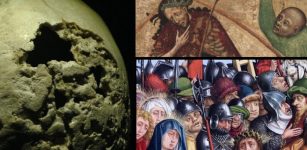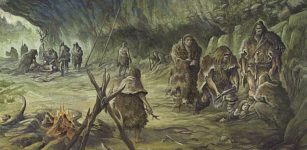How King Arthur Became One Of The Most Pervasive Legends Of All Time
AncientPages.com - King Arthur is one of, if not the most legendary icons of medieval Britain. His popularity has lasted centuries, mostly thanks to the numerous incarnations of his story that pop up time and time again.
Indeed, his is one of the most enduring stories of all time. Though his tale is rooted in the fifth and sixth centuries, it has continued to captivate audiences to this very day. There is just something about the sword in the stone, the knights of the round table, Lancelot, and the wizard Merlin, that have kept us coming back to the various legends of King Arthur for such a long time.
 In the last 15 years alone, there have been Hollywood movies, computer games, and other creative re-tellings. With Bangor University’s new Centre for Arthurian Studies just launched a fortnight ago, and Guy Ritchie’s new movie, King Arthur: the Legend of the Sword, due to be released in late spring, there is no doubt both the scholarly search for Arthur and the impact of his legends on modern culture are continuing to flourish.
In the last 15 years alone, there have been Hollywood movies, computer games, and other creative re-tellings. With Bangor University’s new Centre for Arthurian Studies just launched a fortnight ago, and Guy Ritchie’s new movie, King Arthur: the Legend of the Sword, due to be released in late spring, there is no doubt both the scholarly search for Arthur and the impact of his legends on modern culture are continuing to flourish.
Arthur’s life story is one that has become almost a standard for knightly heroes to aspire to. He is seen as brave, noble, kind – everything that some might say is missing from our modern world.
The epic hero
Few might know that Arthur is a hero whose ancestry goes back to the Brittonic inhabitants of early medieval Wales before the arrival of the Saxons, and not just the kingly figure that appears in later romances. In fact, the Arthur of legend was neither a king, nor the owner of a round table, at least not in the way we use these terms today.
See also:
Tyrfying And Gram: Two Magical Swords In Norse Mythology
Records about Arthur’s life are few and far between. He emerges in the sixth century in the work of the Welsh monk Gildas, where his victory at Mount Badon is celebrated, but he is not named. It is only in the ninth century Historia Brittonum, composed by another monk, Nennius, that Arthur is named as a “dux bellorum”, a military commander, and his 12 battles are listed.
Much time passed between these early records and the 12th century’s full-blown accounts of Arthur’s reign – in the work of Geoffrey of Monmouth and the French Chretien de Troyes, the writers who truly made Arthur the legendary king we now know – and he took on a variety of roles.
In the Welsh stories, Arthur remains a warrior, often a foil for other heroes’ path to greatness. But in the early French romances, he provided a yardstick for courtly behaviour, as epic battles do not form the backbone of these later stories written on the continent.
Geoffrey of Monmouth brought back the leadership and determination of an Arthur who becomes not only a king (on whom 12th century Anglo-Norman kings could model themselves), but also a conqueror – again reflecting a desire for greatness beyond national boundaries. Thus the image of the courtly king, a leader in both war and times of peace, was born.
A modern legend
However, Arthur was always connected to the realities of those countries, and the times and peoples for whom he was reinvented. The Arthurian revival of the late 19th century, for example, helped put him back on the international cultural map by removing the historical aura, and emphasising the values he stood for – a far cry from the medieval attempts to utilise him as a national figure from whom medieval kings could derive their right to rule.
This paved the way to the fantasy worlds created, most famously, by T.H. White in The Once and Future King, published in 1958.
All of these interpretations were about more than just revealing the secrets of one of the most intriguing men of all time. In this confusing and sometimes frightening world, audiences seek reassurance in the models of the past. They want a standard of moral integrity and visionary leadership that is inspirational and transformational in equal measure. One that they cannot find in the world around them, but will discover in the stories of King Arthur.
Is our modern appetite for fantasy a reflection of our need to reinvent the past, and bring hope into our present? Moral integrity, loyalty to one’s friends and kin, abiding by the law and defending the weak, form the cornerstone of how Arthurian fellowship has been defined through the centuries.
They offer the reassurance that doing the morally right thing is valuable, even if it may bring about temporary defeat. In the end, virtues and values prevail and it is these enduring features of the legends that have kept them alive in the hearts and minds of so many through the centuries.
AncientPages.com via The Conversation
More From Ancient Pages
-
 Melusine: Charming Water Fairy In European Legend About Taboo And Broken Promise
Featured Stories | Jan 2, 2019
Melusine: Charming Water Fairy In European Legend About Taboo And Broken Promise
Featured Stories | Jan 2, 2019 -
 Manuscripts And Art Support Evidence That Syphilis Was In Europe Long Before Explorers Could Have Brought It Home
Featured Stories | Jul 15, 2022
Manuscripts And Art Support Evidence That Syphilis Was In Europe Long Before Explorers Could Have Brought It Home
Featured Stories | Jul 15, 2022 -
 On This Day In History: Ceiling Of The Sistine Chapel, Painted By Michelangelo, Is Shown Publicly For The First Time – On Nov 1, 1512
News | Nov 1, 2016
On This Day In History: Ceiling Of The Sistine Chapel, Painted By Michelangelo, Is Shown Publicly For The First Time – On Nov 1, 1512
News | Nov 1, 2016 -
 Neanderthals Buried Their Dead – New Evidence
Archaeology | Dec 10, 2020
Neanderthals Buried Their Dead – New Evidence
Archaeology | Dec 10, 2020 -
 Ancient Viking Age Music Recreated – This Is What It Sounds Like
Featured Stories | Sep 20, 2020
Ancient Viking Age Music Recreated – This Is What It Sounds Like
Featured Stories | Sep 20, 2020 -
 Rasputin – Controversial Mystic With Healing Powers – An Evil Or Misunderstood Man?
Featured Stories | Aug 4, 2018
Rasputin – Controversial Mystic With Healing Powers – An Evil Or Misunderstood Man?
Featured Stories | Aug 4, 2018 -
 Why Did Vikings Hide A Precious Silver Treasure Under The Thralls’ House?
Archaeology | Sep 18, 2024
Why Did Vikings Hide A Precious Silver Treasure Under The Thralls’ House?
Archaeology | Sep 18, 2024 -
 Ancient Andean People Had A Plant-Based Diet And Were Not Hunter-Gatherers
Archaeology | Jan 25, 2024
Ancient Andean People Had A Plant-Based Diet And Were Not Hunter-Gatherers
Archaeology | Jan 25, 2024 -
 Startling Roman-Looking Sandal Discovered Buried Deep Beneath The Snow In Norwegian Mountains
Archaeology | Apr 13, 2022
Startling Roman-Looking Sandal Discovered Buried Deep Beneath The Snow In Norwegian Mountains
Archaeology | Apr 13, 2022 -
 Irkalla – Underworld With No Return Ruled By Ereshkigal, Granddaughter Of Enlil And Sister Of Inanna
Featured Stories | Oct 20, 2021
Irkalla – Underworld With No Return Ruled By Ereshkigal, Granddaughter Of Enlil And Sister Of Inanna
Featured Stories | Oct 20, 2021 -
 Scientists Argue Over The Mysterious Void Discovered Inside The Great Pyramid Of Giza
Archaeology | Nov 8, 2017
Scientists Argue Over The Mysterious Void Discovered Inside The Great Pyramid Of Giza
Archaeology | Nov 8, 2017 -
 Mysterious Handprint And Cry For Justice From Beyond The Grave
Featured Stories | Jan 2, 2020
Mysterious Handprint And Cry For Justice From Beyond The Grave
Featured Stories | Jan 2, 2020 -
 On This Day In History: Powerful And Controversial Roman Emperor Frederick II Excommunicated – On Sep 29, 1227
News | Sep 29, 2016
On This Day In History: Powerful And Controversial Roman Emperor Frederick II Excommunicated – On Sep 29, 1227
News | Sep 29, 2016 -
 On This Day In History: National Hero Paul Revere Warns Of The British Coming – On Apr 18, 1775
News | Apr 18, 2017
On This Day In History: National Hero Paul Revere Warns Of The British Coming – On Apr 18, 1775
News | Apr 18, 2017 -
 3,200-Year-Old Mycenaean Statuette Sheds New Light On The Hittites
Archaeology | Jun 22, 2022
3,200-Year-Old Mycenaean Statuette Sheds New Light On The Hittites
Archaeology | Jun 22, 2022 -
 Batavia Shipwreck Reveals Secrets Of 17th-Century Dutch Seafaring Domination
Archaeology | Oct 30, 2021
Batavia Shipwreck Reveals Secrets Of 17th-Century Dutch Seafaring Domination
Archaeology | Oct 30, 2021 -
 16 Dead Sea Scrolls Fragments Are Forgeries – U.S. Bible Museum Says
Artifacts | Mar 15, 2020
16 Dead Sea Scrolls Fragments Are Forgeries – U.S. Bible Museum Says
Artifacts | Mar 15, 2020 -
 Unique 3,300-Year-Old Hittite Bracelet With Symbols Discovered By Farmer
Archaeology | Mar 28, 2022
Unique 3,300-Year-Old Hittite Bracelet With Symbols Discovered By Farmer
Archaeology | Mar 28, 2022 -
 Hnefatafl: Ancient Viking Board Game “King’s Table” Popular In Medieval Scandinavia
Ancient History Facts | Mar 20, 2016
Hnefatafl: Ancient Viking Board Game “King’s Table” Popular In Medieval Scandinavia
Ancient History Facts | Mar 20, 2016 -
 10,000-Year-Old DNA Offers Insights Into South African Population History
DNA | Sep 24, 2024
10,000-Year-Old DNA Offers Insights Into South African Population History
DNA | Sep 24, 2024


